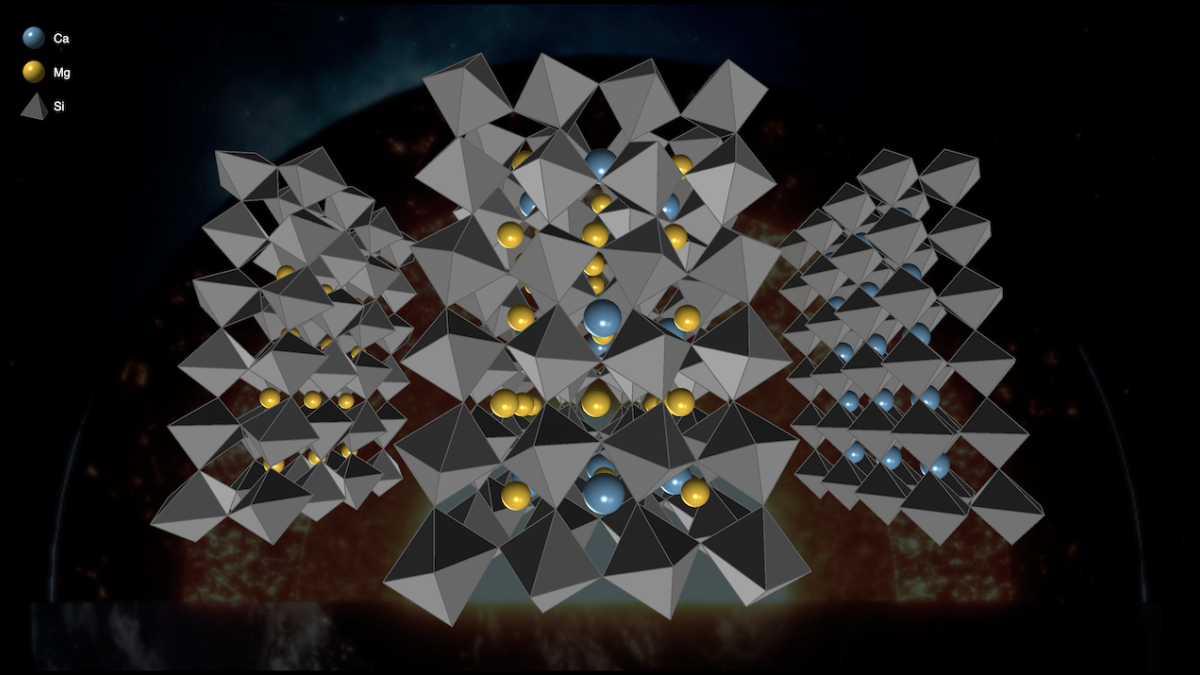ASU researchers discover new mineralogy of the deep Earth

Atomic-scale crystal structures of mantle perovskites. From left to right: Bridgmanite (magnesium rich), new mantle perovskite with both magnesium and calcium, Davemaoite (calcium rich). Credit: Crystal structure images courtesy Dan Shim; background image courtesy iStock/Getty Images.
What is the structure of the Earth? For starters, it consists of several layers: the crust, the upper and lower mantle, and the core.
The mantle makes up most of our planet’s volume — 84%. The lower mantle represents 55% of the Earth’s volume; it is also hotter and denser than the upper mantle.
The lower mantle has played an important role in the Earth’s evolution, including how Earth has cooled over billions of years, how materials have been circulated, and how water is stored and transported from and to the deep interior over a geologic time scale.
For more than seven decades, the mineralogy of the lower mantle has been studied extensively. The decades of studies, including laboratory experiments, computational simulations and the study of inclusions in deep diamonds, led to the conclusion that the lower mantle consists of three main minerals: bridgmanite, ferropericlase and davemaoite.
In a study recently published in Nature, a team of scientists — including Byeongkwan Ko, former PhD student at Arizona State University and now a postdoctoral researcher at Michigan State University, and Dan (Sang-Heon) Shim, professor at ASU's School of Earth and Space Exploration and a Navrotsky Professor of Materials Research at ASU, have completed a new high-pressure experiment employing some different styles of heating to reveal an additional mineral residing in the lower mantle.
Among these three main minerals, two minerals — bridgmanite and davemaoite — have both so-called perovskite-type crystal structures. This structure is also widely known in physics, chemistry and materials engineering, as some materials with the perovskite-type structure have shown superconductivity.
At shallow depths, minerals with similar crystal structures often merge and become single minerals, typically under a high-temperature environment. For example, mineral diopside has both calcium and magnesium, and is stable in the crust. Despite the structural similarity, however, existing studies have shown that davemaoite, rich in calcium, and bridgmanite, rich in magnesium, remain separate throughout the lower mantle.
“Why davemaoite and bridgmanite do not merge to one despite the fact that they have very similar atomic-scale structures? This question has fascinated researchers over two decades,” Shim said. “Many attempts have been made to find conditions where these two minerals merge, yet the answer from experiments has been consistently two separate minerals. This where we felt we need some fresh new ideas in experiments.”
The new experiment was an opportunity for the research group to try various heating techniques to compare methods. Instead of increasing temperature slowly in conventional high-pressure experiments, they increased temperature very fast to the high temperature related to the lower mantle, reaching 3,000 to 3,500 degrees Fahrenheit within a second. The reason for this was that once two perovskite-structured minerals form, it becomes very difficult for them to merge, even if they enter into temperature conditions where single perovskite mineral should be stable.
By heating the samples fast to target temperatures, Ko and Shim were able to avoid formation of two perovskite-structured minerals at low temperatures. Once they reach the temperature of the lower mantle, they monitor what minerals form for 15 to 30 minutes using X-ray beams at the Advanced Photon Source. They found that only single perovskite mineral forms, unexpected from the previous experiments. They found that at sufficiently high temperatures, greater than 3,500 F, davemaoite and bridgmanite become a single mineral in the perovskite-type structure.
“It has been believed that a large size difference between calcium and magnesium, the major cations of davemaoite and bridgmanite, respectively, should hinder these two minerals from merging,” Ko said. “But our study shows that they can overcome such difference in hot environments.”
The experiments suggest that the deeper lower mantle with sufficiently high temperature should have a mineralogy different from the shallower lower mantle. Because the mantle was much warmer in early Earth, the group’s new results indicate that most of the lower mantle had a single perovskite-structured mineral then, which means the mineralogy differed from the present-day lower mantle.
This new observation has a range of substantial impacts on our understanding of the deep Earth. Many seismic observations have shown that the deeper lower mantle properties are different from the shallower lower mantle. The changes are reported to be gradual. The merge of bridgmanite and davemaoite is shown to be gradual in the research group’s experiments. Also, the properties of a rock with three main minerals — bridgmanite, ferropericlase and davemaoite — does not match well with the properties of the deeper lower mantle. Ko and collaborators predict that these unresolved problems can be explained by a merge of bridgmanite and davemaoite to a new single perovskite-structured mineral.
Other contributing authors on this study are Eran Greenberg, University of Chicago; Vitali Prakapenka, University of Chicago; E. Ercan Alp, Argonne National Laboratory; Wenli Bi, University of Alabama at Birmingham; Yue Meng, Argonne National Laboratory; Dongzhou Zhang, University of Chicago and University of Hawai’i at Mano.
More Science and technology

Turning up the light: Plants, semiconductors and fuel production
What can plants and semiconductors teach us about fuel production?ASU's Gary Moore hopes to find out.With the aim of learning how…

ASU technical innovation enables more reliable and less expensive electricity
Growing demand for electricity is pushing the energy sector to innovate faster and deploy more resources to keep the lights on…

What do a spacecraft, a skeleton and an asteroid have in common? This ASU professor
NASA’s Lucy spacecraft will probe an asteroid as it flys by it on Sunday — one with a connection to the mission name.The asteroid…

